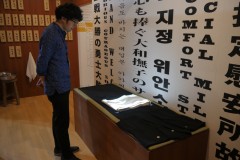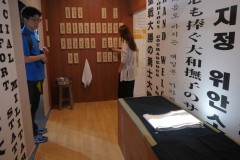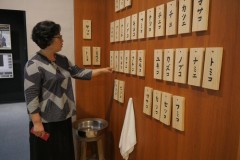Re-creation of a Military Comfort Station
The National Museum of Korean Contemporary History (대한민국 역사박물관), Seoul, Korea, 2017
Traveling Exhibit at Museums and Cultural Centers in 4 major cities in Korea:
The National Museum of Korean Contemporary History, Seoul (대한민국 역사박물관)
The Chonbuk National University Museum, Chunju (전북대학교박물관)
Daejeon Artist House, Daejeon (대전예술가의집)
Daegu Art Center, Daegu (대구문화예술회관)
Presented by The Korean Ministry of Gender Equality and Family, The Korean Institute for Gender Equality Promotion and Education (한국양성평등교육진흥원)
Additional support by The Foundation for Contemporary Arts Emergency Grant
Re-creation of a Military Comfort Station is based on historical references, my video recordings of former comfort stations, and interviews with “comfort women” survivors and a former Japanese soldier in 7 different countries in Asia.
In the installation, welcoming and regulations banners are hung from floor to ceiling at the entrance, and on the walls inside. During the war, banners at the entrances of military comfort stations welcomed and attracted soldiers. The banners, in multiple languages including Korean, Japanese, and English, display historical written texts such as “Official Military Hometown Comfort Station,” “Japanese Girls Dedicating Their Hearts and Bodies in Service,” and “Grand Welcome to Victorious, Courageous Soldiers.”
Inside, videos play on elements in the room:
A 10 minute B&W video excerpt (in Korean & English) of “COMFORT WOMEN WANTED” plays in a window. The video is based on the artist’s interviews across Asia, with Korean, Chinese, Taiwanese, Indonesian, Filipino, and Dutch “comfort women” survivors, and with a former Japanese soldier.
The color video of recordings of four former comfort station buildings (still existing in China and Indonesia today) are projected on a kimono belt on a tatami bed. One video is of “Dai Salon” in Shanghai, China, the first comfort station ever established (1932), another is of “Mei Mei Li,” also in China. Two more videos are from former Indonesian comfort stations, including one of “blue house” where Emah Kastima, an Indonesian women survivor, was held for 2 years during the war.
On the walls of the art installation, Japanese name plaques are hung, just as in the original comfort stations. Girls were forced to wear kimonos and use artificial made-up Japanese names to obscure and erase their true ethnic identity. In one corner sits a solitary washing bowl, evoking a sense of emptiness and loss.
Women News (Korean):
https://m.news.naver.com/read.nhn?mode=LSD&sid1=001&oid=310&aid=0000060470
http://m.news.naver.com/read.nhn?mode=LSD&mid=sec&sid1=102&oid=310&aid=0000060334
KBS TV News (Korean):












